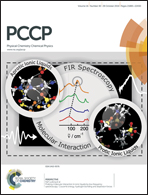Probe dependent anomalies in the solvation dynamics of coumarin dyes in dimethyl sulfoxide–glycerol binary solvent: confirming the local environments are different for coumarin dyes†
Abstract
The solvation dynamics of coumarin dyes in dimethyl sulfoxide (DMSO)–glycerol (GLY) binary mixtures were studied across the GLY concentrations. Three coumarin dyes with widely different hydrophobicities were used for probing the entire polarity regions of this solvent mixture. Multiple anomalous concentration regions with significantly slow solvation times were detected from all three coumarin dyes. However, their precise positions were found to be probe molecule dependent. The solvation dynamics of the moderately hydrophobic dye coumarin 480 (C480) maintain a plateau region with a similar solvation time (∼550 ps) with the increase in GLY concentration until XGLY (the mole fraction of glycerol) reaches 0.5. This plateau region is followed by a sudden slowdown (to ∼975 ps) on the addition of more GLY to the DMSO–GLY mixture, and then this slow region persists from XGLY ∼ 0.55 to 0.65 (peak at 0.6). On further addition of GLY (XGLY > 0.7), the solvation dynamics again become slower to ∼828 ps (at XGLY ∼ 0.8) from ∼612 ps (at XGLY ∼ 0.7). For very high GLY-content samples (XGLY > 0.85), the solvation times remain similar on further changes of the GLY concentrations. In contrast to C480, the most hydrophobic dye coumarin 153 (C153) shows a linear increase of solvation time in the DMSO–GLY mixture, from 102 ps (at XGLY ∼ 0.1) to 946 ps (at XGLY ∼ 0.9) with increase in GLY concentration, except for the concentration region, XGLY ∼ 0.45–0.55 (peak at 0.5), where a substantial slowdown of the solvation time is observed. The highly hydrophilic probe coumarin 343 (C343) demonstrates multiple concentration regions (XGLY ∼ 0.05–0.10, 0.25–0.35 and 0.55–0.65) where the solvation dynamics are significantly retarded. The presence of probe dependent anomalies in the DMSO–GLY mixture is a clear indication of there being different locations of probe molecules within this solvent mixture. We assume that the slowing-down of the solvation time could be a reflection of several aspects, including the inherit inhomogeneity, intriguing structural transformations in the DMSO–GLY mixture, percolation among DMSO molecules and network structure formation, where DMSO:GLY complexes contribute to the dynamical features.


 Please wait while we load your content...
Please wait while we load your content...